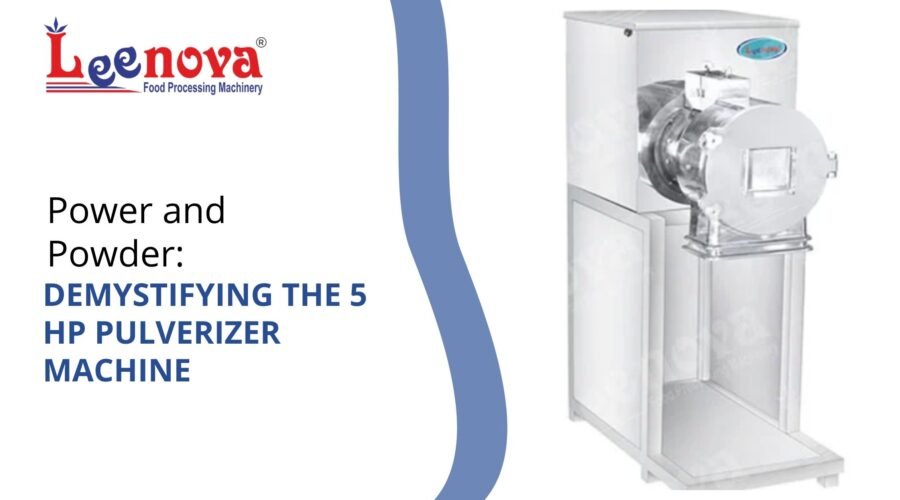In every small commercial kitchen, there’s a moment when “buying flour” quietly turns into “we should be milling this ourselves.” A 5 HP pulverizer is the tipping point: compact enough for a tight back room, powerful enough to change your unit economics. This guide strips away brochure fluff and gets practical—what 5 HP really delivers, how capacity claims translate to your shift schedule, and which features matter when it’s 6:30 p.m. and orders won’t stop.
We’ll use Leenova’s 5 HP pulverizer as the benchmark to frame the discussion—purely as a reference point for specs, operations, and what “good” looks like at this tier.
Snapshot / Overview: What a 5 HP Pulverizer Actually Is
A 5 HP pulverizer is an impact-type grinder designed for multi-material duty: grains, pulses, and spices. Think of it as the workhorse middleweight—far more serious than a tabletop domestic unit, yet still manageable for bakeries, cloud kitchens, kirana grinders, and small processing units. In the real world, you’re buying three things: repeatable fineness (mesh control), stable throughput under load, and uptime that doesn’t depend on good luck. If you run diverse SKUs—atta, besan, ragi, basic masalas—a 5 HP machine is the first step where variety doesn’t instantly crush your schedule.
Price & Purchase At-a-Glance
Most buyers look for a quick gut-check before the deep dive: an indicative price band, the power/phase, and what’s included (sieves? cyclone? starter kit?). Expect to see “transportation/installation extra” and taxes clearly called out, with a Request Quote or Add to Enquiry CTA rather than hard pricing. That’s normal; freight, local taxes, and variant choices (MS vs SS, cyclone, chamber size) swing the final number. What matters more than the sticker is the total package: spares, service responsiveness, and clarity on warranty coverage.
Key Highlights (the pattern you’ll see everywhere)
- 2-in-1 versatility: flour + masala positioning, so you can run wheat at 11 a.m. and coriander at noon—if you respect cleaning SOPs.
- Compact footprint: designed to fit real kitchens, not just catalog pages.
- Quick changeovers: tool-less or easy sieve swaps reduce “dead minutes.”
- Dust management: cyclone or collector options to keep air and surfaces sane.
- Operator-friendly: simple controls, predictable feed behavior, and sensible noise levels for an impact mill.
- Protection & stability: overload protection, sane wiring recommendations, and guidance on stabilizers for voltage-wobbly sites.
Technical Specifications (what to expect and what to question)
Specs aren’t just numbers; they’re proxies for performance.
- Motor / Phase / RPM / Voltage: 5 HP motor, typically ~2800–2880 RPM. Many units offer single-phase or three-phase options; serious duty cycles favor three-phase.
- Capacity: catalog claims often say “30–50 kg/hr” or similar. Treat these as directionally correct; actuals depend on grain type, moisture, mesh, and operator feed rate.
- Chamber & Cutting Mechanics: look for clear chamber dimensions (e.g., 12″×6″ or 12″×7″ class), liner material, and cutter details. Balanced rotors matter for vibration, heat, and bearing life.
- Build: MS powder-coated body is common; SS (often 202) may be offered for food-zone or audit-intense environments. Check weld quality, access panels, and wheel/caster sturdiness.
- Power Consumption: many vendors quote “units per hour.” Use that only as a baseline; energy per 100 kg processed is the smarter KPI.
- Footprint & Weight: plan for a compact rectangle plus safe working clearance; weight typically sits in the ~80–150 kg band depending on build and options.
If a spec sheet looks perfect but says nothing about cleanability, service intervals, or sieve compatibility, ask harder questions.
Applications (and where expectations go to die)
A credible 5 HP unit should handle wheat/atta, rava, besan, pulses, millets, sugar, salt, and common spices/herbs—with the right mesh and feed discipline. Variety is not a free lunch: flour residue and spice oils don’t mix, so you’ll need a real cleaning SOP between categories. If you sell gluten-sensitive foods, formalize your cross-contamination routine. Your customers will thank you, and your audit trail will, too.
Power & Electricals (the unglamorous deal-breaker)
You can run 5 HP on single phase in many contexts, but if your daily window is long or your load is heavy, three-phase is the grown-up choice. It handles start-up current better, keeps performance consistent under voltage swings, and protects your motor life. Overspec your wiring slightly; underspec’d cables become space heaters and sabotage grind quality. Fit proper MCB/overload devices and consider a stabilizer if your area’s power is moody. Then track kWh per 100 kg instead of “units per hour”—that KPI bakes productivity into your energy metric.
Build & Hygiene (cleanability beats cleverness)
Great machines are designed to be cleaned by real people in real time. Look for:
- Fast access to chamber and discharge; fewer tools, fewer excuses.
- No dead zones where flour cakes and goes stale.
- Dust discipline: cyclone or effective capture reduces airborne mess (and lungs).
- Vibration control: pads and balanced rotors protect bearings and operator patience.
- Food-grade contact parts where it matters; surface finishes that actually wipe clean.
You’ll know a practical design when your operator starts cleaning without muttering. If the machine fights them, standards will slip on day three.
Capacity in the Real World (claims vs shift math)
Throughput is a function of material (wheat vs millet vs masala), moisture, mesh, and feed rate. The catalog number is your ceiling on a good day; plan your operations around the median. Use a simple equation: desired daily output ÷ milling hours = target kg/hr. Then add 20–30% headroom for changeovers and sanity. If you peak on festival weeks or weekends, size for the peaks—not the sleepy Tuesdays. The cheapest machine that overheats and forces rework will cost you more than the slightly pricier option that runs cool and steady.
Variants & Add-Ons (how choice is structured)
At 5 HP you’ll commonly see:
- Single-chamber (lean, compact) vs double-chamber (more control, sometimes better uniformity).
- Cyclone variants to improve dust control and collection efficiency.
- MS vs SS bodies for different hygiene and audit needs.
- Caster/mobility kits for tight, reconfigurable kitchens.
- Sieve packs (carry the meshes you’ll actually use).
- Noise enclosures where neighbors or operators demand peace.
The small extras—spare belts, common meshes, a labeled tool roll—pay for themselves in the first “we can’t be down right now” moment.
FAQ (the questions you’ll really be asked)
Can it run on single phase?
Often yes, but for heavy, continuous shifts and cleaner starts, three-phase is the better call. It’s not overkill; it’s reliability.
What’s the actual capacity on wheat/besan/spices?
Expect a band, not a single number. Wheat on medium-fine mesh is usually faster than oily spices on fine mesh. Time three representative batches and make your baseline.
Do I need a foundation?
Most 5 HP units don’t need a civil foundation. A stable, level floor with basic vibration pads is enough. Mobility helps in cramped kitchens.
How much power will it consume?
Use kWh per 100 kg as your yardstick. It normalizes both energy and throughput; track it weekly to catch declining performance.
What’s the maintenance cadence?
Daily wipe-downs, sieve inspections, and “listen for weird noises.” Weekly deeper cleaning and fastener checks. Periodic inspection of beaters/liners or stones (model-dependent) plus belts and bearings.
How do I control dust?
Choose a cyclone/collector if dust is a concern, enforce a cleaning SOP, and store finished flour in sealed containers—dust is both a hygiene and a morale problem.
Can one machine handle wheat, millets, pulses, and spices?
Yes—with realistic expectations, smart mesh selection, and disciplined cleaning between categories. If you’re serious about allergens or gluten, put it in writing and follow it.
Related Products / Step-Up Paths
A good buying page will show adjacent SKUs: 3 HP (for very light, intermittent milling), 7.5 HP (for longer windows or denser load), and 10 HP (when throughput and headroom are the strategy, not the luxury). You’ll also see stone-based models for traditional atta texture and cyclone variants for dust control and yield. Use these cards not as distractions but as sanity checks: Does your real schedule argue for a step up—or would a 5 HP with better SOPs do the job?
Ops & SOPs: Where Machines Become Systems
Hardware choices are half the game; the other half is how you run them. Build a minimal but real SOP: pre-shift checks (wiring, noise, sieve), mid-shift temperature watch (warm flour equals compromised shelf life), changeover routine (clean, swap, inspect), and end-of-shift hygiene (wipe, empty, store). Keep a hot-spares kit on site: belts, your three most-used meshes, and the wear parts your model actually consumes. Train the team to pause on anomalies—weird smell, rising temperature, unusual vibration. One calm pause beats an hour of “why is this flour clumping?”
Buying Checklist (vendor-agnostic, reality-proof)
- Capacity target with headroom: your peak day, not your average, drives the spec.
- Electrical fit: phase, wiring gauge, MCB/overload, and stabilizer decisions done before delivery.
- Fineness control: meshes you’ll actually use, plus speed of swap.
- Thermal behavior: cooler grind equals happier dough and longer shelf life.
- Noise & vibration: protect operators, protect bearings.
- Dust management: cyclone or disciplined capture.
- Cleanability: how many minutes from “we’re done” to “we’re clean.”
- Spares & service: response times, not just warranty months.
- Documentation & training: SOP beats “ask Rajesh, he knows.”
- Trial mindset: whenever possible, test with your grains and meshes.
Closing (brand integration #2)
A 5 HP pulverizer isn’t just a machine; it’s a promise to your future self that tomorrow’s dough prep won’t be a coin toss. Choose by throughput math, electrical stability, cleanability, and TCO—then validate on your floor with your materials. If the grind stays cool, the mesh holds, and your kWh per 100 kg behaves, you’ve picked right. To see what a well-sorted 5 HP package looks like in practice, explore Leenova’s 5 HP pulverizer and request a demo or quote based on your actual SKUs and shift plan. When numbers line up with taste and texture, that’s not luck—it’s good engineering meeting good operations.


